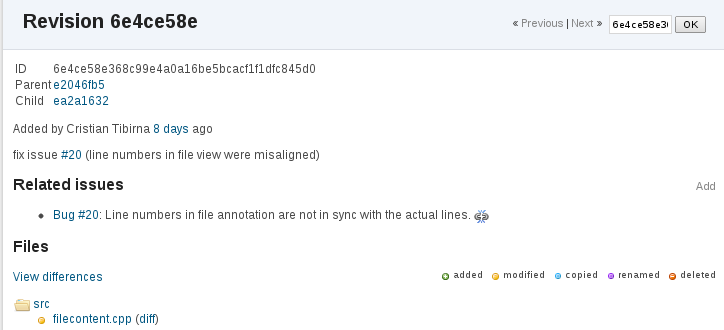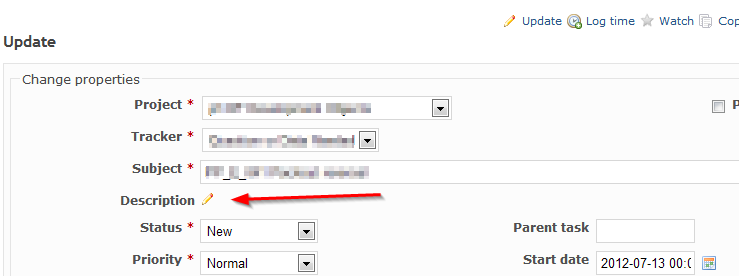RedmineIssues » History » Revision 38
« Previous |
Revision 38/47
(diff)
| Next »
redmineservices ., 2013-06-27 18:10
Corrections of start date and due dates of parent task.
Issue Tracking¶
- Table of contents
- Issue Tracking
Issues are the heart of the Redmine business. An issue is bound to a project, owned by a user, can be related to a version, etc.
Listing of the issue¶
From a selected issue page, you can see the work in progress that is done to fix the issue. The messages are displayed in chronological order, (to change the order - see the setting in 'My Accounts'). It is possible to quote others' messages as well as to edit yours.
Related issues¶
'Related issues' allow developers to link issues to each other in order to remove duplicates or simplify their workflow.
It is possible to link issues based on various relations. Current relations are:- related to - Just adds a link to the other issue
- duplicates - Links issues so that closing one, will close the other (e.g. closing A will close B)
For example, if issue B duplicates A:
- closing B will leave A open
- closing A will automatically close B
- duplicated by - Reciprocal of duplicates
For example, if issue A is duplicated by issue B:
- closing B will leave A open
- closing A will automatically close B
- blocks - Links issues so that closing one can be blocked by an issue which is still open
If issue B blocks A,
A can't be closed unless B is. - blocked by - Reciprocal of blocks
- precedes - Links issues to define an "order", where A needs to be completed x days before B can be started on
If B follows A, you can't give B
a starting date equal or less
than the ending date of A. - follows - Reciprocal of precedes
If issue B follows A (ex A ends the 21/04 and B begins the 22/04)
and you add +2 day at the ending date of A,
the starting and ending dates of B will be +2 too.

Administrators can define the permissions of users to add and edit such relations.
Watchers¶
Display a list of all the users who are watching this issue. If the issue is updated, those users will be notified.
If you are logged in as a project administrator, it is possible for you to add users to the watch list on this page. By clicking on the Add link, a drop-down menu with a Add button appear, which allows you to select which user to add to the watch list.

Administrators can define the permissions of users to add/delete watchers as well as to see the list of watchers.
Associated revisions¶
If the administrator has defined Referencing Issues Keywords, a developer that uses such keyword(s) will see its commit message displayed on the issue page, under the Associated revisions block (generally to the right of the first reply).

Revisions can also be associated to issues manually, from a changeset (revision) view in the Repository browser. The manual associations are reversible. They can be revoked by using the broken chain icon to the right of an added association, again in the changeset view.

Adding a new issue¶
People can create a new issue when they meet the roles and permissions configured by the Redmine Administrator (Role: Issue Tracking > Add Issues).
When creating a new issue, one of the most important items is the tracker field, which defines the nature of the issue. By default, Redmine comes with three different trackers: bug, feature, and support.
Updating an existing issue¶
(TODO: describe and upload a screen-shot of update panel)
To edit the issue, Click Update link (having a pencil icon) at the top or the bottom of the issue page:

Depending you your role permissions (see roles and permissions), you will see a complete or a limited set of editable issue properties.
Editing an existing issue's Subject or Description¶
In order to edit an existing issue, your role has to have the Issue Tracking > Edit Issues right in the the roles and permissions configuration.
This right gives you a (More) link after the Change Properties section title in the "Update issue" panel.
- Open the issue
- Click Update link (having a pen icon) at the top or the bottom of the issue page.
- See Change properties dialog with the (More) link (see a screenshot below).
- Clicking on the (More) link will bring-up an editable copy of the Subject and Description of the issue.

For version 2.0 onwards, the (More) link does not exist any more. Instead the subject line is editable by default. The description of the issue has pencil icon right next to it that you can click to change the description.

Subtasks¶
Subtasks (#443) were introduced in Redmine 1.0.0 (RC). They are integrated in r3573, r3574, r3576, r3577 and refined in r3618. They are fixed in r3593, r3633, r3677 and r4061. Subtask related changes for Parent issues are made in r3617, r3671, r3821 and r3869.
You can update an issue and access the "More" link to (re)set the "Parent task" field. This can be used to "convert" a normal issue into a subtask, move a subtask from one parent to another, or convert a subtask to a normal issue.
- Subtasks can belong to a different project than the parent task, dependent on the configuration switch in admin settings.
- Subtasks are rescheduled when a 'precedes' relation is set on a parent task.
- The parent task is available as a column in issues list for sorting and filtering.
- The parent subtasks issue hierarchy is displayed in issues when list is sorted by parent.
- Descendant issues are displayed in a tree on the issue view with context menu support.
- The parents subtasks issue tree is also copied on project copy.
- Subtasks feature allows unlimited nesting.
- Defining subtasks requires the new permission 'Manage subtasks'.
- The parent task's done percentage is the weighted average ratio of subtasks.
- The parent task's start is the lowest date of subtasks.
- The parent task's due date is the highets due date of the latest subtask.
- The parent task's spent time is the sum of the subtasks' spent times.
- The parent task's estimation time is the sum of the subtasks' estimation times.
- The parent task's priority is the highest of the subtasks' priorties.
TODO, extend (please keep the revision info above for referencing while this TODO is current).
Updated by redmineservices . almost 12 years ago · 38 revisions